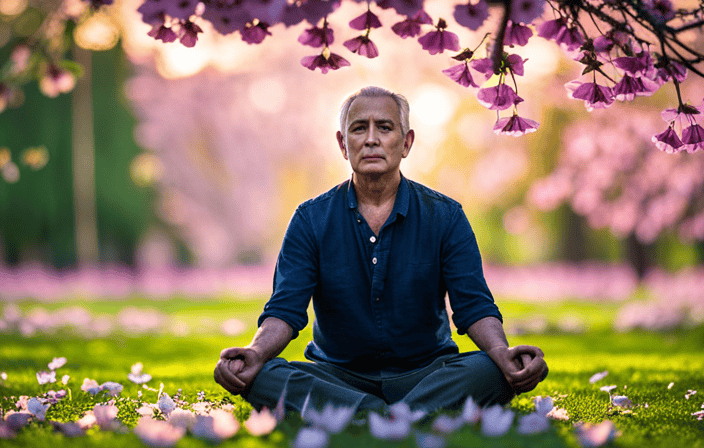In a constantly busy world, finding inner peace can seem like an impossible dream. We try different methods to achieve peace, but meditation is a unique choice. It’s ironic that meditation, aimed at promoting calmness, greatly depends on the timing of our practice.
This article explores the question of when to meditate, delving into the pros and cons of different timings, offering tips for bedtime meditation, and discussing the benefits of integrating meditation into our daily routines.
Join us on this journey of discovering the perfect timing for finding inner peace through meditation.
Key Takeaways
- Meditating before bed is not recommended due to alertness and potential sleep disturbances.
- Meditating before bed may be easier to fit into the schedule and can lead to quicker falling asleep and longer, deeper sleep.
- To fit meditation into your schedule, you can wake up earlier or sleep a little later, set reminders, use visible reminders, or replace mindless activities with meditation.
- Regular meditation has numerous benefits such as reducing stress and anxiety, improving focus and concentration, enhancing emotional well-being, boosting creativity, and promoting better sleep quality.
When to meditate?
Determining the optimal time to meditate is crucial for achieving inner peace. Meditating before bed may result in alertness and potential sleep disturbances. On the other hand, meditating earlier in the day offers benefits such as increased alertness and concentration. The best time for meditation varies among individuals, as each person has a unique schedule and body clock.
However, experts suggest that meditating in the morning, before the day’s activities begin, can set a positive tone for the day ahead. This allows individuals to start their day with a clear and focused mind. Additionally, meditating in the morning helps to establish a consistent practice and ensures that it is not neglected later in the day when fatigue or other distractions may arise.
Overall, finding the optimal meditation timing depends on personal preference and experimentation, as everyone’s needs and schedules may differ.
Pros and Cons
Weighing the advantages and disadvantages of practicing meditation at different times can help individuals make informed decisions about incorporating it into their daily routines. The impact of timing can greatly influence the benefits and drawbacks of meditation.
One of the pros of meditating before bed is that it may be easier to remember and fit into the schedule, especially when the day is done and the to-do list is finished. Additionally, meditating before bed can lead to quicker and longer periods of sleep, making it ideal for individuals with insomnia.
However, there are cons to consider as well. Meditating before bed may result in feeling groggy the next day and difficulty concentrating on meditation when tired. It is important to experiment with different types of meditation and adjust the timing of the session to find the optimal time frame for each individual.
Before Bed
One consideration for practicing meditation before bed is that it may disrupt sleep and result in feelings of grogginess and difficulty concentrating on the practice. However, there are certain benefits of nighttime meditation that can be beneficial for some individuals.
Meditating before bed can help to calm the mind and prepare it for sleep, leading to a quicker and deeper sleep. It can also be an ideal practice for those who struggle with insomnia.
To ensure that meditation before bed does not interfere with sleep, it is recommended to test the impact on sleep duration and quality on days with no early obligations. Additionally, experimenting with different types of meditation and adjusting the timing of the session can help find the optimal time frame.
Techniques such as meditating with soothing music and tracking sleep duration can also be helpful in finding the right balance for nighttime meditation.
Tips for Bedtime Meditation
To optimize the practice of bedtime meditation, it is recommended to experiment with different meditation techniques and adjust the timing of the session to find the most suitable time frame for a restful and rejuvenating sleep.
By testing the impact on sleep and tracking sleep duration, individuals can determine the ideal time to meditate before bed.
Additionally, trying different types of meditation, such as mindfulness or guided visualization, can help improve sleep quality.
Some individuals may also find that meditating with calming music enhances relaxation and promotes a deeper sleep.
It is important to find a balance between alertness and relaxation during bedtime meditation to avoid potential sleep disturbances.
Through these tips and adjustments, bedtime meditation can be a beneficial practice for improving sleep and enhancing relaxation.
Fitting Meditation into Schedule
Scheduling meditation sessions can be challenging, but individuals can effectively integrate this practice into their daily routines by finding the right time and making it a part of their morning routine. By waking up a little earlier or going to bed a little later, individuals can create time for meditation. Setting digital alerts or placing visible reminders like sticky notes can serve as helpful reminders. Additionally, using a calendar or planner to schedule meditation sessions can ensure consistency. It is also important to replace mindless activities with meditation to prioritize inner peace. By reevaluating the schedule and integrating meditation with existing daily activities, individuals can successfully fit meditation into their busy lives. The table below provides some strategies for fitting meditation into a daily schedule:
| Strategies for Fitting Meditation into Schedule |
|---|
| Wake up earlier or sleep a little later |
| Set digital alerts or use visible reminders |
| Use a calendar or planner to schedule sessions |
| Replace mindless activities with meditation |
Incorporating meditation into one’s morning routine can help individuals find the time and create a calm and focused start to their day, ultimately leading to inner peace.
Integrating with Daily Activities
Integrating meditation with daily activities allows individuals to seamlessly incorporate this practice into their routines and experience its benefits throughout the day. By combining meditation with exercise, individuals can enhance their physical well-being while also promoting mental clarity and focus. Engaging in activities such as a morning jog or evening yoga session can serve as a mindful meditation practice, allowing individuals to be present in the moment and cultivate a sense of inner peace.
Additionally, using meditation symbols as reminders can help individuals stay consistent with their practice. Wearing a meditation symbol or carrying a meaningful object can serve as a visual cue, prompting individuals to pause and engage in a brief meditation session throughout the day. This serves as a reminder to maintain mindfulness and bring a sense of calmness into their daily activities.
By integrating meditation with exercise and utilizing symbols as reminders, individuals can create a harmonious balance between their inner and outer worlds, fostering a greater sense of peace and well-being.
Benefits of Regular Meditation
Regular meditation offers a range of benefits, including reductions in stress and anxiety, improvements in focus and concentration, enhanced emotional well-being, increased creativity and problem-solving abilities, and better sleep quality.
It has been scientifically proven to have positive effects on mental health by reducing symptoms of depression and anxiety. Through regular practice, meditation helps individuals develop a greater sense of self-awareness, allowing them to better understand their thoughts, emotions, and behaviors.
This increased self-awareness can lead to a deeper understanding of oneself and others, improving relationships and overall well-being. Additionally, meditation has been found to increase gray matter in the brain, which is associated with improved cognitive function and memory.
Overall, incorporating regular meditation into one’s routine can have profound effects on mental health, increasing self-awareness and promoting inner peace.
Scientific Effects of Meditation
Scientific research has revealed a multitude of physiological and psychological effects associated with the practice of meditation. Numerous studies have consistently shown that meditation can have positive effects on both physical and mental health. Some of the scientifically proven benefits include reducing blood pressure and the risk of heart disease, enhancing immune system function, alleviating symptoms of depression and anxiety, increasing gray matter in the brain, and even slowing down the aging process. These findings highlight the significant impact that meditation can have on overall well-being.
To provide a visual representation of the effects of meditation, the following table summarizes some of the key scientific studies and their corresponding health benefits:
| Scientific Studies | Health Benefits |
|---|---|
| Reduces blood pressure | Decreases the risk of heart disease |
| Enhances immune system function | Improves overall health and well-being |
| Alleviates symptoms of depression and anxiety | Reduces psychological distress and improves mood |
| Increases gray matter in the brain | Enhances cognitive function and memory |
| Slows down the aging process | Promotes healthy aging and longevity |
These scientific findings further emphasize the importance of incorporating regular meditation practice into one’s routine to achieve optimal physical and mental health.
Different Types of Meditation
There are various types of meditation techniques that individuals can practice to achieve different outcomes and benefits.
One popular type is mindfulness meditation, which involves focusing one’s attention on the present moment without judgment. This practice has been shown to reduce stress and anxiety, improve focus and concentration, enhance emotional well-being, and promote better sleep quality.
Another technique is loving-kindness meditation, where individuals cultivate feelings of compassion and goodwill towards themselves and others. This practice can increase feelings of empathy, reduce negative emotions, and improve interpersonal relationships.
Other types of meditation include transcendental meditation, guided visualization meditation, and mantra meditation, each with its own specific techniques and benefits.
Ultimately, the choice of meditation technique depends on an individual’s goals and preferences.
Meditation Apps and Resources
Meditation apps and resources provide individuals with convenient access to various guided meditation techniques and tools for incorporating meditation into their daily routine. These resources offer a range of meditation techniques, allowing users to explore and choose the method that resonates with them the most.
Whether it’s mindfulness meditation, loving-kindness meditation, transcendental meditation, guided visualization meditation, or mantra meditation, these apps and resources offer guided sessions that can help individuals achieve a state of inner peace and relaxation.
The benefits of meditation are well-documented, and these apps and resources make it easier for individuals to experience these benefits. Regular meditation practice has been shown to reduce stress and anxiety, improve focus and concentration, enhance emotional well-being, boost creativity and problem-solving abilities, and promote better sleep quality.
By providing accessible and user-friendly platforms, meditation apps and resources empower individuals to incorporate meditation into their daily lives and reap the rewards of this ancient practice.
Some popular meditation apps and resources include Headspace, Calm, Insight Timer, The Mindfulness App, and 10% Happier. These platforms offer a variety of guided meditations, mindfulness exercises, sleep aids, and other tools to support individuals on their meditation journey.
Overcoming Challenges
One of the common challenges individuals may encounter in their meditation practice is the restlessness and difficulty in maintaining stillness during the session, which can be addressed through the use of various techniques and strategies. Finding the right meditation technique that suits one’s preferences and needs can greatly assist in overcoming restlessness. Mindfulness meditation, for example, focuses on bringing attention to the present moment, allowing individuals to observe their thoughts and sensations without judgment. Another technique is loving-kindness meditation, which involves cultivating feelings of love and compassion towards oneself and others. Additionally, incorporating physical movements, such as yoga or walking meditation, can help individuals who find it difficult to sit still. Setting specific goals and finding motivation can also aid in maintaining a regular meditation practice. By reminding oneself of the benefits and purpose of meditation, individuals can find the necessary motivation to overcome challenges and continue their journey towards inner peace.
| Meditation Techniques | Finding Motivation |
|---|---|
| Mindfulness meditation | Setting specific goals |
| Loving-kindness meditation | Reminding oneself of benefits |
| Physical movements | Cultivating motivation |
| Focusing on purpose of meditation | |
| Seeking inspiration from others |
Frequently Asked Questions
How long should I meditate for each session?
The duration of each meditation session can vary depending on personal preference and schedule. However, it is generally recommended to start with shorter sessions, such as 5-10 minutes, and gradually increase the duration as one becomes more comfortable. Consistency in daily meditation practice is key to experiencing the best meditation techniques and reaping the benefits of daily meditation.
Can I meditate on an empty stomach?
Meditating on an empty stomach can enhance focus and clarity, but it’s important to listen to your body’s needs. It’s crucial to find a balance between hunger and comfort to ensure a successful meditation practice.
Is it better to meditate indoors or outdoors?
Both indoor and outdoor settings can be conducive to meditation, but the impact of natural surroundings can enhance the practice. Outdoor meditation offers the benefits of fresh air, natural sounds, and connection with nature, while indoor meditation provides a controlled and quiet environment for focused meditation.
Can I meditate after a meal?
Meditating after a meal can be beneficial as it allows for a relaxed state and aids digestion. However, it may cause drowsiness and discomfort. Mindful eating can be an alternative way to incorporate meditation techniques after a meal.
Is it necessary to sit in a specific position while meditating?
Different meditation positions can be used, such as sitting on a cushion, cross-legged on the floor, or on a chair. Using a meditation cushion can provide benefits such as improved posture, comfort, and stability during meditation.










